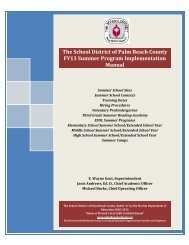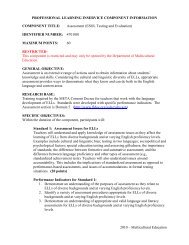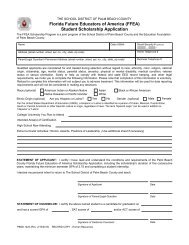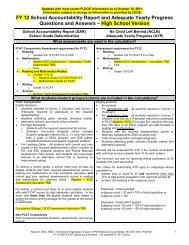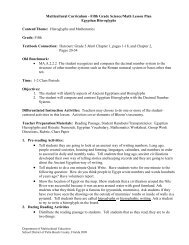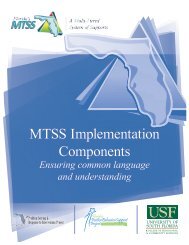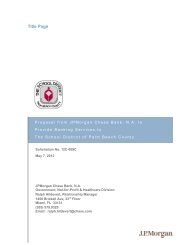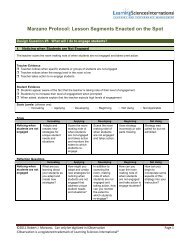Fathers with low literacy and their young children - The School ...
Fathers with low literacy and their young children - The School ...
Fathers with low literacy and their young children - The School ...
Create successful ePaper yourself
Turn your PDF publications into a flip-book with our unique Google optimized e-Paper software.
Diane Karther<br />
<strong>Fathers</strong> in this study valued <strong>literacy</strong><br />
learning. <strong>The</strong>y monitored <strong>their</strong><br />
<strong>children</strong>’s progress <strong>and</strong><br />
participated in book reading<br />
despite <strong>low</strong> direct<br />
program involvement.<br />
<strong>Fathers</strong> <strong>with</strong> <strong>low</strong> <strong>literacy</strong><br />
<strong>and</strong> <strong>their</strong> <strong>young</strong><br />
<strong>children</strong><br />
<strong>The</strong> role of parents in <strong>children</strong>’s <strong>literacy</strong><br />
development has been well documented<br />
(Morrow, 1989; Sulzby & Edwards,<br />
1993). Prior home <strong>literacy</strong> studies tended to focus<br />
on maternal influences in <strong>young</strong> <strong>children</strong>’s<br />
<strong>literacy</strong> learning (Dickinson, De Temple, &<br />
Smith, 1992; Marvin & Mirenda, 1993;<br />
Pellegrini, Perlmutter, Galda, & Brody, 1990).<br />
Interest in the father’s role in the lives of <strong>children</strong><br />
has increased, <strong>and</strong> men have responded to<br />
the changes <strong>with</strong>in U.S. society by assuming<br />
roles as nurturing caregivers <strong>and</strong> active teachers<br />
of <strong>their</strong> <strong>children</strong> (Lamb, 1997).<br />
Studies have shown that fathers can have remarkable<br />
effects on <strong>children</strong>’s <strong>literacy</strong> <strong>and</strong><br />
school achievement. <strong>The</strong> 1996 National<br />
Household Education Survey (Nord, Brimhall,<br />
& West, 1997) indicated that <strong>children</strong> are more<br />
likely to get A’s, participate in extracurricular activities,<br />
<strong>and</strong> enjoy school <strong>and</strong> are less likely to<br />
repeat a grade if <strong>their</strong> fathers are involved in<br />
<strong>their</strong> schools. Gallimore, Reese, Balzano,<br />
Benson, <strong>and</strong> Goldenberg (1991) saw a positive<br />
relationship between the amounts of <strong>literacy</strong> fathers<br />
engage in for <strong>their</strong> personal use <strong>and</strong> <strong>their</strong><br />
<strong>children</strong>’s reading test scores. Laosa (1982)<br />
found that fathers had more effect on <strong>their</strong> sons’<br />
reading achievement than mothers did.<br />
A particular paternal influence is expectation<br />
for <strong>children</strong>’s future achievement. In a report<br />
on intergenerational <strong>literacy</strong> programs,<br />
Nickse (1990) noted that parental attitude toward<br />
education <strong>and</strong> aspirations for the child, in<br />
addition to conversations <strong>and</strong> reading materials<br />
in the home, contribute more directly to early<br />
reading achievement than socioeconomic status.<br />
Ortiz, Stile, <strong>and</strong> Brown (1999) found that interest<br />
in school readiness <strong>and</strong> a desire for a closer<br />
relationship <strong>with</strong> <strong>their</strong> <strong>children</strong> motivated fatherchild<br />
<strong>literacy</strong> activities.<br />
Levels of fathers’ <strong>literacy</strong> involvement <strong>with</strong><br />
<strong>their</strong> preschoolers vary. Several factors contribute<br />
to this. Parents <strong>with</strong> a higher education<br />
tend to participate in more child <strong>literacy</strong> activities<br />
than less educated parents (Laosa, 1982).<br />
Spousal roles are another factor. Levine,<br />
Murphy, <strong>and</strong> Wilson (1993) suggested that “how<br />
men relate to <strong>children</strong> is influenced by how they<br />
think <strong>and</strong> feel about <strong>their</strong> role” (p. 9). Ortiz<br />
(1996) reported that fathers who shared child<br />
rearing responsibilities <strong>with</strong> <strong>their</strong> spouses were<br />
more likely to read to <strong>their</strong> <strong>children</strong>. It may be<br />
that fathers <strong>with</strong> more traditional role definitions<br />
tend to delegate these activities to mothers.<br />
What about fathers whose early experiences<br />
<strong>with</strong> <strong>literacy</strong> <strong>and</strong> school were discouraging <strong>and</strong><br />
who continue to struggle <strong>with</strong> <strong>low</strong> <strong>literacy</strong><br />
skills? How do they view <strong>literacy</strong> experiences<br />
for <strong>their</strong> <strong>children</strong>? Do they engage in <strong>literacy</strong> activities<br />
<strong>with</strong> them as readily as other fathers?<br />
This article presents the attitudes <strong>and</strong> <strong>literacy</strong><br />
practices of fathers <strong>with</strong> <strong>low</strong> <strong>literacy</strong> or limited<br />
academic achievement. <strong>The</strong>ir attitudes toward<br />
the importance of <strong>literacy</strong> activities, the value<br />
of education, <strong>and</strong> <strong>their</strong> aspirations for themselves<br />
<strong>and</strong> <strong>their</strong> <strong>children</strong> are included.<br />
184<br />
<strong>The</strong> Reading Teacher Vol. 56, No. 2 October 2002 ©2002 International Reading Association (pp. 184–193)
Study background<br />
Data were derived from case studies of families<br />
enrolled in an Even Start Family Literacy<br />
program in a city in north-central West Virginia,<br />
USA. <strong>The</strong> city, <strong>with</strong> a population of approximately<br />
26,700, is home to a major state university.<br />
<strong>The</strong> city <strong>and</strong> county have experienced the<br />
decline of the coal industry, which has resulted<br />
in widespread poverty in the region. Although<br />
many people there do have jobs, many are underemployed<br />
or have transient employment.<br />
<strong>The</strong> federally funded Even Start Family<br />
Literacy Program is designed to improve the educational<br />
opportunities of <strong>low</strong>-income families<br />
by providing early childhood education, parenting<br />
skills, <strong>and</strong> adult education. <strong>The</strong> West Virginia<br />
program components include addressing the <strong>literacy</strong><br />
<strong>and</strong> educational needs of parents <strong>and</strong> <strong>children</strong>,<br />
training parents to be the first <strong>and</strong> primary<br />
teachers for <strong>their</strong> <strong>children</strong>, <strong>and</strong> providing skills<br />
to help parents gain self-sufficiency. Families<br />
qualify for participation in the program if (a)<br />
they have <strong>children</strong> up to age 7; (b) at least one<br />
parent needs further education to obtain employment,<br />
a Graduate Equivalency Diploma (GED),<br />
or <strong>literacy</strong> skills; <strong>and</strong> (c) they reside in a Head<br />
Start attendance area <strong>with</strong>in the county.<br />
<strong>The</strong> Even Start program services consist of<br />
weekly or bimonthly home visits averaging one<br />
<strong>and</strong> one half hours by a family educator trained<br />
in early childhood education who offers developmentally<br />
appropriate activities. A selection of<br />
<strong>children</strong>’s books are previewed <strong>and</strong> left for families<br />
to read. Simple book extension activities<br />
such as artwork or puppet construction are begun<br />
during the home visit. <strong>The</strong> family educators<br />
model book reading but only rarely read an entire<br />
book <strong>with</strong> the child. <strong>The</strong>y encourage parents<br />
to do the activities <strong>with</strong> the <strong>children</strong>. Art supplies<br />
are provided to families who have a need. <strong>The</strong><br />
educators also link services <strong>with</strong> Head Start,<br />
Special Education, <strong>and</strong> Title I programs in the<br />
county schools. (Title I is a federally funded<br />
reading program.)<br />
For parenting education, the educators use information<br />
from the nationally accredited “Parents<br />
as Teachers” curriculum. Adult education consists<br />
of adult basic education, computer skills, <strong>and</strong><br />
preparation for GED or college testing. Employment<br />
counseling <strong>and</strong> preparation for interviews<br />
<strong>and</strong> job procurement are also offered. <strong>The</strong> program<br />
coordinates <strong>with</strong> a variety of social service<br />
agencies <strong>and</strong> center-based adult <strong>and</strong> preschool education<br />
to assist families <strong>with</strong> <strong>their</strong> needs.<br />
Each family in the study had two preschoolaged<br />
<strong>children</strong>. All parents were married, <strong>and</strong> all<br />
were European American. Each of the families<br />
qualified for food stamps <strong>and</strong> other public assistance.<br />
This report includes descriptions of two<br />
fathers from an earlier study (Karther, 1996) of<br />
three families. In that study data were collected<br />
during home visits <strong>with</strong> an initial data period<br />
<strong>and</strong> an eight-week fol<strong>low</strong>-up. In the original<br />
study design, the data consisted of semistructured<br />
interviews <strong>with</strong> the mothers (Seidman,<br />
1991) <strong>and</strong> the mothers’ responses to hypothetical<br />
learning situations <strong>and</strong> to book reading <strong>with</strong><br />
<strong>their</strong> <strong>children</strong>. Auxiliary information came from<br />
interviews <strong>with</strong> two Even Start parent educators<br />
<strong>and</strong> from Even Start home environment<br />
questionnaires <strong>and</strong> <strong>literacy</strong> tests.<br />
<strong>The</strong> mothers <strong>and</strong> <strong>children</strong> were the primary<br />
program participants over the two months of the<br />
earlier study. <strong>The</strong> fathers had no direct Even<br />
Start program involvement <strong>and</strong> none of them<br />
participated in the parent-child activities during<br />
the home visits. However, during the data collection,<br />
the researcher noticed a father observing<br />
the home visit. <strong>The</strong> researcher decided to<br />
explore interviewing the fathers, <strong>and</strong> permission<br />
was granted through requests from <strong>their</strong> wives.<br />
Two fathers agreed to semistructured interviews.<br />
Data were analyzed using a phenomenological<br />
approach as described by Hycner (1985),<br />
which involved identification of meaning units<br />
from carefully prepared transcripts of each taped<br />
interview. Statements were segmented, categorized,<br />
<strong>and</strong> then grouped according to similar <strong>and</strong><br />
related meanings. Common themes <strong>and</strong> groupings<br />
were examined to determine similarities<br />
<strong>and</strong> differences.<br />
Portraits of the families<br />
<strong>The</strong> Marsh family (pseudonyms are used for<br />
all family names)<br />
This family consisted of Mike, the father;<br />
Mary, the mother; a son, age 3; <strong>and</strong> a 6-monthold<br />
daughter. Mary was 19 <strong>and</strong> had been married<br />
to Mike for two years. Mike, age 22, was stepfather<br />
of the boy <strong>and</strong> natural father of the girl.<br />
<strong>The</strong> family lived in a small two-bedroom trailer<br />
<strong>Fathers</strong> <strong>with</strong> <strong>low</strong> <strong>literacy</strong> <strong>and</strong> <strong>their</strong> <strong>young</strong> <strong>children</strong> 185
in a mobile-home park <strong>with</strong>in the city limits. <strong>The</strong><br />
living <strong>and</strong> kitchen area of the trailer contained<br />
little more than a sofa, arm chair, coffee table,<br />
TV cabinet, kitchen table, <strong>and</strong> chairs. <strong>The</strong> baby’s<br />
highchair was stacked on the kitchen table when<br />
not in use. <strong>The</strong>re was a fish tank in the living<br />
room. <strong>The</strong> family had a cat <strong>and</strong> a dog.<br />
Both of the parents had high school diplomas.<br />
Mike had completed vocational education<br />
training <strong>and</strong> had been in a class for students <strong>with</strong><br />
learning disabilities because he had “trouble<br />
<strong>with</strong> his reading.” Mike reported that he “had a<br />
hard time sitting in regular class unless it was<br />
interesting.” He told the researcher, “When I was<br />
<strong>young</strong>er I had so much trouble reading I didn’t<br />
really push myself on to it.” He proudly said that<br />
he made a 3.5 grade point average his last year of<br />
high school. Mike described his learning of auto<br />
mechanics as, “If you go in <strong>and</strong> learn the basics...then<br />
you can figure it out from there. That<br />
is the way I have always been. If I want to know<br />
how something works I tear it apart.” Mike completed<br />
high school because, according to him, his<br />
parents had a rule “that you ain’t leavin’ home<br />
’til you get a high school diploma.”<br />
Mike’s family history revealed limited education<br />
levels. His father had quit school at age 14<br />
to go to work in the coal mines, <strong>and</strong> his mother<br />
had been forced to quit in the ninth grade because<br />
the family couldn’t afford school books.<br />
His mother’s health had been frail, <strong>and</strong> Mike’s<br />
sister was the homework helper for the <strong>children</strong>.<br />
From late high school, Mike had a stable work<br />
history doing auto mechanic work. He enjoyed<br />
“doing anything to be working <strong>with</strong> your h<strong>and</strong>s.”<br />
He had recently quit a repair shop job, where he<br />
had worked for five years, because of the night<br />
<strong>and</strong> weekend work. At the time of the study,<br />
Mike was underemployed as an auto glass installer.<br />
He was glad to have weekends <strong>and</strong><br />
evenings free to be <strong>with</strong> his family. According<br />
to the Even Start educator, the family qualified<br />
for food stamps.<br />
In the interview Mike expressed his plan to<br />
return to school to learn more auto body mechanics<br />
so that he could operate his own garage.<br />
Speaking <strong>with</strong> much sincerity, he described his<br />
“wild dream” of having an all-purpose shop<br />
someday. He admitted to the researcher that he<br />
wished he could start over <strong>with</strong> high school because<br />
“it would do me good. I really wish I could<br />
go through <strong>and</strong> straighten up a year or so of<br />
classes.... Now I wish I would have kicked myself<br />
<strong>and</strong> tried to pick up an extra class.” When<br />
asked about this he explained that the extra class<br />
would be math because “you need more math<br />
nowadays; it’s used in auto repair work.”<br />
Fol<strong>low</strong>-up questions by the Even Start educator<br />
revealed that Mike had declined an offer of referral<br />
for further education <strong>and</strong> a reading test because<br />
of his full-time employment.<br />
Child-care roles in this family were shared.<br />
Mary cared for the <strong>children</strong> during the day <strong>and</strong><br />
was the primary teacher of the <strong>children</strong>. Mike<br />
assisted her in the evenings <strong>with</strong> some of the<br />
physical caregiving. This was reported on the<br />
HOME Screening Questionnaire (Coons, Gay,<br />
F<strong>and</strong>al, Ker, & Frankenburg, 1981). Specific<br />
tasks for each parent were not reported.<br />
Even Start involvement. <strong>The</strong> family heard<br />
about Even Start from a neighbor <strong>and</strong> enrolled<br />
because of Mary’s desire to help her <strong>children</strong> <strong>and</strong><br />
Mike’s initial interest in furthering his education.<br />
At the initial data collection the family had received<br />
two months of Even Start services, which<br />
consisted of weekly home visits. Mike was never<br />
present during the Even Start visits because he<br />
was at work. Paperwork <strong>and</strong> adult <strong>and</strong> child testing<br />
for the national Even Start evaluation were<br />
done during the first three visits. Each intervention<br />
home visit averaged one <strong>and</strong> one half hours,<br />
in which time the parent educator did two or<br />
three <strong>literacy</strong> activities <strong>with</strong> the 3-year-old while<br />
the mother assisted. For example, one time they<br />
made stick puppets <strong>and</strong> reenacted the story of<br />
“<strong>The</strong> Three Little Pigs.” After working <strong>with</strong> the<br />
child, the educator discussed Mary’s questions<br />
<strong>and</strong> concerns about the <strong>children</strong>. Her main concerns<br />
were about the baby’s motor development<br />
<strong>and</strong> getting her son to sleep by himself. An average<br />
of five or six <strong>children</strong>’s books of the mother’s<br />
choice were left <strong>with</strong> the family. One or two<br />
infant books were also left by the parent educator.<br />
Other materials such as dominoes, paints,<br />
<strong>and</strong> play clay were provided for family use.<br />
During the home visits, Mary seemed comfortable<br />
<strong>with</strong> the parent educator <strong>and</strong> talked easily<br />
<strong>with</strong> her. Her son was very excited to see the<br />
educator <strong>and</strong> addressed her as “teacher.” It was<br />
evident that the family used the books that were<br />
left for them because on one home visit the<br />
3-year-old repeated the storylines to the parent<br />
educator <strong>and</strong> was anxious to get the “new” books<br />
for the week. <strong>The</strong> mother kept track of the<br />
186<br />
<strong>The</strong> Reading Teacher Vol. 56, No. 2 October 2002
parenting information sheets that were given to<br />
her by storing them in a notebook provided by<br />
Even Start. For a short time she recorded her<br />
son’s reactions to the Even Start books. She did<br />
not continue this for more than a few weeks,<br />
however, claiming a “busy schedule.”<br />
Initial family <strong>literacy</strong> opportunities. Both<br />
parents indicated that before Even Start intervention<br />
they provided <strong>their</strong> son <strong>with</strong> books. At<br />
the initial data collection, they owned more than<br />
10 <strong>children</strong>’s books. <strong>The</strong> Even Start educator<br />
reported that on the HOME Screening Questionnaire<br />
they had indicated fewer than nine books<br />
for adults. <strong>The</strong> titles of these were unavailable.<br />
<strong>The</strong>y purchased <strong>and</strong> borrowed preschool videotapes<br />
<strong>and</strong> also had crayons <strong>and</strong> watercolors to<br />
“help <strong>with</strong> his [<strong>their</strong> son’s] learning.” However,<br />
Mary reported that she monitored her son <strong>with</strong><br />
crayons because he chewed off the paper <strong>and</strong><br />
broke the crayons more than he drew <strong>with</strong> them.<br />
She good-humoredly showed the researcher<br />
some crayon scribbles on the furniture saying,<br />
“That is his artist job there.”<br />
<strong>The</strong> family owned some toys relating to alphabet<br />
recognition, a wooden rotating alphabet<br />
block puzzle, other blocks, toy bricks, trucks,<br />
musical toys, a toy telephone, <strong>and</strong> plastic tools.<br />
<strong>The</strong> researcher noted a small stack of women’s<br />
magazines in the living room, notes posted on<br />
the refrigerator, <strong>and</strong> an appointment calendar<br />
<strong>and</strong> address book that the mother used. <strong>The</strong>re<br />
was no computer in the home.<br />
Both Mike <strong>and</strong> his wife reported valuing<br />
family times. As Mike said, “<strong>The</strong> biggest part of<br />
the time [at home] is spent <strong>with</strong> our kids.... We<br />
are not partiers or nothing.... We try to get both<br />
of them [the <strong>children</strong>] involved in something.”<br />
Mike <strong>and</strong> Mary spent leisure time taking <strong>their</strong><br />
<strong>children</strong> to a city park, <strong>and</strong> Mike reported that he<br />
enjoyed watching his son ride his bike.<br />
Parent-child <strong>literacy</strong> activities. Parent-child<br />
reading was done primarily by Mary. She said<br />
that she was the main “reader” in the family. She<br />
reported that she began to read to her first child<br />
when she was pregnant; she read her high school<br />
books aloud. At the time of the first data collection,<br />
she had no regular routine reading time but<br />
responded to her son’s request to read, which<br />
usually was in the afternoon when the baby was<br />
asleep. Mary did not report reading daily to her<br />
<strong>children</strong> but read several times per week. Her<br />
husb<strong>and</strong> described himself as “not a book person.”<br />
Mike said that he “didn’t read a lot” to <strong>their</strong><br />
son but did read some books that had transportation<br />
themes. <strong>The</strong> researcher interpreted his reading<br />
to mean that he mostly showed his son the<br />
pictures in the book <strong>and</strong> discussed the trucks.<br />
Parental reading consisted of the mother scanning<br />
women’s magazines for recipes <strong>and</strong> Mike<br />
reading magazines about auto electronics <strong>and</strong><br />
equipment.<br />
Father’s teaching behaviors. In an attempt<br />
to underst<strong>and</strong> his parental role definitions, the researcher<br />
asked Mike if he considered himself a<br />
teacher of his <strong>children</strong>. He responded <strong>with</strong> a<br />
shrug <strong>and</strong> negative nod of the head. He said <strong>with</strong><br />
hesitation, “Hum, like I say, I try to teach them<br />
stuff. I mean I know parents that really sit down<br />
<strong>and</strong> try playing school.... I don’t believe in pushing<br />
it, you know, drilling it into them, but I do<br />
want them to get a good education.”<br />
When asked what he has done to help his<br />
son learn, Mike’s responses were related to his<br />
mechanical interests. He reported that he had<br />
tried to teach his son to ride a bicycle. He also<br />
al<strong>low</strong>ed the child to watch him repair bikes <strong>and</strong><br />
the car to “start him out <strong>young</strong>,” to get him interested<br />
in repairing things. He had taught the<br />
child the names of his tools. Mike appreciated<br />
the child’s ability to learn. As Mike said enthusiastically,<br />
“I try to teach him how, but a lot of<br />
it is him, like I said he is so curious, you just<br />
got to try <strong>and</strong> explain it to him <strong>and</strong> show him<br />
how it works.”<br />
Father’s reaction <strong>and</strong> changes after Even<br />
Start intervention. Mike felt his 3-year-old benefited<br />
from the program. He said it encouraged<br />
the child to read more books because the Even<br />
Start books were viewed by his son as “special.”<br />
Mike relayed that he was pleased that Even Start<br />
involved his wife because “she gets to do stuff<br />
<strong>with</strong> books <strong>and</strong> she’s showed me stuff they’ve<br />
done together.” He felt that Even Start helped the<br />
entire family by encouraging time together. He<br />
said, “It gives us more of something, as far as<br />
involving all of us, it gives us the chance to sit<br />
down. And he [the son] seems more interested<br />
in books.... He tells me about his teacher all of<br />
the time.” He proudly showed the researcher a<br />
detailed collage that his son had made for him<br />
<strong>with</strong> the Even Start educator. Obviously glad his<br />
son made it for him, Mike said, “It makes me<br />
feel good.... I am happy to see it.”<br />
<strong>Fathers</strong> <strong>with</strong> <strong>low</strong> <strong>literacy</strong> <strong>and</strong> <strong>their</strong> <strong>young</strong> <strong>children</strong> 187
<strong>The</strong> Marshes reported that before Even Start<br />
Mary had a hard time finding something to do<br />
<strong>with</strong> her son. She was pleased to receive many<br />
activity ideas <strong>and</strong> said that her son worked on<br />
them until he ran out of supplies or completed an<br />
activity. She said that her son would “sit <strong>and</strong> do<br />
it for hours, but before the Even Start educator<br />
started coming around, it’s like ‘there’s nothing<br />
to do.’”<br />
Both Mary <strong>and</strong> Mike felt that Even Start<br />
helped <strong>their</strong> son learn. Mary claimed that he<br />
learned his numbers from the Even Start educator.<br />
Another change for the Marsh parents was a<br />
conscientious effort to read to <strong>their</strong> <strong>children</strong> in a<br />
more systematic way, particularly at bedtime.<br />
Mike had begun reading the Curious George<br />
books <strong>with</strong> his son. He had increased book reading<br />
frequency, reading almost every day to his<br />
son. <strong>The</strong>y did not, however, report an established<br />
routine to read to the infant.<br />
Mike felt that because Even Start targeted<br />
the whole family it might help people who often<br />
ignore <strong>their</strong> <strong>children</strong> <strong>and</strong> don’t know how to<br />
communicate as a family. He explained, “it may<br />
give them a reason to start spending time <strong>with</strong><br />
<strong>their</strong> kids” <strong>and</strong> help them “as far as learning<br />
what to do <strong>with</strong> the kids, finding what’s interesting<br />
for <strong>their</strong> kids to know.” Mike told the researcher<br />
he would have liked to be more actively<br />
involved <strong>with</strong> Even Start <strong>and</strong> suggested that<br />
home visits be scheduled at a time when he was<br />
off work. Sensing the benefit to his son, he said,<br />
“maybe that would help...keep him interested<br />
even more.”<br />
Value of education <strong>and</strong> aspirations for <strong>children</strong>.<br />
Mike connected the importance of education<br />
<strong>and</strong> book reading to a brighter future. In a<br />
conversation about his hopes for his <strong>children</strong>’s<br />
future he said, “I didn’t mind being a mechanic...but<br />
when you look at your kids you always<br />
want better for them than what you are doing.”<br />
He went on to say earnestly,<br />
but if he [his son] is going to take to books, just because I<br />
am doing something different don’t mean I won’t push him,<br />
you know, back him in what he is going to do.... If he wants<br />
to go to school I definitely, if I had to take four or five jobs to<br />
get him through I would.... I hope to see him go to college,<br />
both of them.<br />
<strong>The</strong> Smith family<br />
Jim <strong>and</strong> his wife, Sally, had a 4-year-old<br />
daughter <strong>and</strong> 15-month-old son. Jim was 29<br />
years old <strong>and</strong> his wife was 32. <strong>The</strong> family lived<br />
in a subsidized housing project <strong>with</strong>in the city<br />
limits. <strong>The</strong>ir townhouse apartment was attractively<br />
furnished <strong>with</strong> an upholstered sofa <strong>and</strong><br />
chair <strong>and</strong> decorated <strong>with</strong> cheery pictures on the<br />
wall. <strong>The</strong>y had a pet parrot in a cage in the dining<br />
room <strong>and</strong> some fish in a tank in the living<br />
room. <strong>The</strong> housing project had a large <strong>children</strong>’s<br />
playground <strong>and</strong> was centrally located to stores.<br />
<strong>The</strong> Smiths knew several residents of the community,<br />
<strong>and</strong> Jim reported assisting some neighbors<br />
<strong>with</strong> car repairs.<br />
Sally had completed high school <strong>and</strong> training<br />
programs as a nursing assistant <strong>and</strong> medical<br />
assistant. She was taking one course in a vocational<br />
nursing program at the time of the study.<br />
Jim did not complete high school. He dropped<br />
out in the ninth grade, at age 14, after a brain injury<br />
from an auto accident. He read at the thirdgrade<br />
level (according to the Even Start<br />
educator). Jim had held previous jobs in maintenance<br />
<strong>and</strong> light construction. Neither parent<br />
was employed at the time of the study; they lived<br />
on public assistance.<br />
Jim reported that in his elementary years he<br />
had speech problems; he had trouble “pronouncing<br />
my vowels <strong>and</strong> my letters.” He told the researcher<br />
that his auto injury during ninth grade<br />
“knocked his reading down” because he had<br />
been reading at a sixth-grade level before his accident.<br />
Although he received special education<br />
services at a “school for people under average”<br />
he could not regain his ability to read. Jim explained,<br />
“I didn’t exactly have any help so I got<br />
frustrated <strong>and</strong> stopped trying to learn to read.”<br />
He decided to drop out of school when they<br />
placed him in the cafeteria <strong>and</strong> gym each semester<br />
<strong>with</strong> no special assistance. Jim saw his <strong>low</strong><br />
reading skills as a disadvantage: “If I can’t read,<br />
I can’t learn anything though. If I could read I<br />
could learn myself how to do some of those<br />
things. I could pick up a lot.”<br />
Jim remembered that during his childhood<br />
his family lived in Baltimore, Maryl<strong>and</strong>, <strong>and</strong> in<br />
West Virginia. He received limited assistance<br />
<strong>with</strong> schoolwork from his mother <strong>and</strong> said that<br />
if she had helped him more, he might have<br />
learned more. He made no mention of his father.<br />
His older sister was the one who helped him<br />
188<br />
<strong>The</strong> Reading Teacher Vol. 56, No. 2 October 2002
<strong>with</strong> homework. Jim had enrolled in adult education<br />
classes three times in Baltimore <strong>and</strong> also<br />
in West Virginia. He quit each program due to<br />
frustration. He said, “I didn’t go back because<br />
it didn’t seem like I was learning any more or<br />
getting any farther.”<br />
<strong>The</strong> Smiths’ son was born six weeks prematurely<br />
<strong>and</strong> received early intervention services.<br />
<strong>The</strong> mother reported that his last evaluation<br />
showed him to be developing normally <strong>and</strong><br />
above normal in gross motor skills. <strong>The</strong>ir daughter<br />
was diagnosed six months prior to the study<br />
<strong>with</strong> developmental delays. <strong>The</strong> mother reported<br />
that her diagnosis was a behavior disorder <strong>and</strong><br />
two years’ developmental lag. At the time of the<br />
study, the girl was attending Head Start <strong>and</strong> receiving<br />
special services.<br />
For the Smiths, child-care responsibilities<br />
were primarily Sally’s. She took care of all of<br />
the physical needs of the <strong>children</strong> <strong>and</strong> communicated<br />
<strong>with</strong> the teachers <strong>and</strong> professionals providing<br />
services to the family. On the HOME<br />
survey she reported that Jim did caregiving<br />
three to four times per week. This was when she<br />
was in class or volunteering in her daughter’s<br />
Head Start class.<br />
Even Start involvement. <strong>The</strong> Smiths had received<br />
two months of Even Start services at the<br />
beginning of the study. <strong>The</strong>y were referred by<br />
the Head Start staff. Sally had enrolled in Even<br />
Start to help her daughter <strong>and</strong> in hopes that Jim<br />
could receive adult education <strong>and</strong> <strong>literacy</strong> services.<br />
This family had an Even Start parent educator<br />
who visited them twice a month. Typically<br />
Sally <strong>and</strong> her daughter were the primary participants.<br />
Jim was in the apartment for about a third<br />
of the visits but never participated directly. He<br />
was observed to speak briefly <strong>with</strong> the Even<br />
Start educator on a few occasions.<br />
During each visit, the parent educator discussed<br />
the books introduced at the previous visit.<br />
Sometimes she read one of them to the<br />
daughter. <strong>The</strong>n she did two to three book extension<br />
activities such as the stick puppet reenactment<br />
of “<strong>The</strong> Three Little Pigs.” She brought<br />
toddler toys for the <strong>young</strong>est child, <strong>and</strong> the researcher<br />
observed both <strong>children</strong> playing <strong>with</strong><br />
them. <strong>The</strong> two <strong>children</strong> had a high interest level<br />
in the educator’s activities. <strong>The</strong>ir mother sat<br />
close by but did not say much to the <strong>children</strong>.<br />
She did interact <strong>with</strong> the parent educator <strong>and</strong> reported<br />
her daughter’s Head Start progress. She<br />
did not have many questions for the parent educator<br />
but did mention wanting her husb<strong>and</strong> to enroll<br />
in a reading program. A second concern of<br />
hers was the daughter’s emotional outbursts. <strong>The</strong><br />
parent educator provided “Parents as Teachers”<br />
materials for her <strong>and</strong> suggested some parenting<br />
tips. <strong>The</strong> educator always left a selection of<br />
books for the 4-year-old <strong>and</strong> some for the toddler.<br />
On occasion she left other materials such<br />
as a book <strong>with</strong> an audiotape <strong>and</strong> a cassette tape<br />
player.<br />
Initial family <strong>literacy</strong> opportunities. <strong>The</strong><br />
Smiths had both <strong>children</strong>’s <strong>and</strong> adult <strong>literacy</strong> materials<br />
in <strong>their</strong> home. <strong>The</strong> adult <strong>literacy</strong> materials<br />
were Sally’s textbooks. Sally reported that<br />
she was the main reader in the family. On the<br />
HOME survey, she reported having over 20<br />
adult books <strong>and</strong> 10 <strong>children</strong>’s books that were<br />
stored in the <strong>children</strong>’s rooms. <strong>The</strong> <strong>children</strong>’s<br />
books were ones that are commonly available<br />
in grocery <strong>and</strong> chain stores. <strong>The</strong> family also had<br />
subscriptions to a <strong>children</strong>’s book club <strong>and</strong> a<br />
Bible book club, <strong>and</strong> they had a Sunday newspaper<br />
subscription.<br />
A computer was in the living room <strong>with</strong> several<br />
containers of disks. Jim explained that they<br />
had a learning program that was on alphabet <strong>and</strong><br />
number recognition, but he really wanted to have<br />
“Reader Rabbit.” <strong>The</strong> majority of the computer<br />
programs were adult recreational games, which<br />
Jim copied from friends.<br />
<strong>The</strong> <strong>children</strong> had access to pens <strong>and</strong> pencils<br />
in the living room. On a high shelf was a basket<br />
of coloring books <strong>and</strong> crayons, which Sally controlled.<br />
On one occasion, the researcher noticed<br />
the daughter using a large pad of paper, which<br />
she labeled as her notebook. <strong>The</strong> <strong>children</strong> also<br />
had a magnetic drawing pad on which to draw<br />
<strong>and</strong> write. Many developmentally appropriate<br />
play materials were in the home. <strong>The</strong>se included<br />
an alphabet toy, a pegboard, a toy telephone,<br />
musical toys, a shape sorter, play clay, blocks, a<br />
chalkboard, toy dishes, dress-up costumes, <strong>and</strong><br />
toy bricks. <strong>The</strong> mother also let her <strong>children</strong> play<br />
<strong>with</strong> a broken clock.<br />
Parent-child <strong>literacy</strong> activities. Sally provided<br />
numerous <strong>literacy</strong> activities for the <strong>children</strong>.<br />
During the first study interview, she<br />
pointed to a tape player <strong>with</strong> a recorded storybook<br />
tape in it that was on loan from Even Start<br />
<strong>and</strong> said lightheartedly that the <strong>young</strong>est “has to<br />
listen to that tape every day—over <strong>and</strong> over.”<br />
<strong>Fathers</strong> <strong>with</strong> <strong>low</strong> <strong>literacy</strong> <strong>and</strong> <strong>their</strong> <strong>young</strong> <strong>children</strong> 189
She also said a family favorite was the Alphabet<br />
Soup game that her daughter liked to play. This<br />
game involves matching letters to object pictures.<br />
<strong>The</strong> mother began reading to her daughter<br />
when she was 2 or 3 years old. She said she usually<br />
read five or six books to her at bedtime. Her<br />
favorite books were those that had animals in<br />
them. <strong>The</strong> mother also reported showing picture<br />
books to her son.<br />
Jim said that he read to the <strong>children</strong> infrequently.<br />
He explained that because he could not<br />
read the words, he left the reading to Sally. He<br />
did, however, enjoy showing picture books to his<br />
son when his wife was not available. According<br />
to Jim, he liked the hardback picture books “because<br />
he [his son] likes to touch them.” He added<br />
that his son “sometimes gets more book reading<br />
than our daughter, but the reason is that he wants<br />
to turn the pages <strong>and</strong> look at them.” <strong>The</strong> researcher<br />
noted on a home visit that the daughter’s<br />
attention problems were evident when the<br />
mother <strong>and</strong> the Even Start educator tried to read<br />
to her. She looked at a book for no more than 3<br />
minutes <strong>and</strong> then abruptly jumped down off the<br />
couch to start a new activity. This may have accounted<br />
for Jim’s comments about the <strong>young</strong>est<br />
child being more interested in the books.<br />
Father’s teaching behaviors. When asked if<br />
he felt he was a teacher of his <strong>children</strong>, Jim<br />
shrugged his shoulders <strong>and</strong> responded, “I try to<br />
teach her [his daughter].” Jim reported taking<br />
an active interest in teaching his daughter the alphabet.<br />
Although he added, “I don’t know much<br />
about trying to teach them because I can’t read.”<br />
He had tried to teach her to use the alphabet<br />
recognition computer program. <strong>The</strong> researcher<br />
observed him point to an item on the screen <strong>and</strong><br />
then encourage his daughter to say the alphabet<br />
letter <strong>and</strong> the object. This was not very successful.<br />
His daughter became easily distracted <strong>and</strong><br />
hopped down from his lap. He expressed discouragement<br />
stating, “At first she was interested,<br />
but I can’t keep her interested.”<br />
He has plans to teach his <strong>young</strong> son—like<br />
Mike Marsh—fol<strong>low</strong>ing traditional male roles.<br />
Jim explained, “When he gets a little older I<br />
could probably learn him a lot of my skills that<br />
I know because I can do anything outside from<br />
the inside <strong>and</strong> from top to bottom, from roofing<br />
to plumbing <strong>and</strong> electrical.”<br />
Father’s reaction <strong>and</strong> changes after Even<br />
Start intervention. After a month of Even Start<br />
services, Jim fol<strong>low</strong>ed through on a referral to an<br />
adult <strong>literacy</strong> program. His wife reported that it<br />
was helping him improve his reading. He admitted<br />
that he would not have enrolled in another<br />
reading class on his own. Neither his wife nor his<br />
sister could persuade him in the past. He reported<br />
that he adopted a new way to help himself<br />
learn to read. He recorded his lessons on an<br />
audiocassette recorder <strong>and</strong> replayed them. He<br />
also was using the computer to learn new words.<br />
He indicated his difficulty in mastering reading<br />
by saying,<br />
It’s s<strong>low</strong> <strong>and</strong> long term. I know a lot of it is just like I am going<br />
over a track where I have been before...so after I go so far<br />
I probably will have lots of hard times. It is going to be a long<br />
time before I get to the end of the track.<br />
He was also continuing to work <strong>with</strong> his<br />
daughter on alphabet recognition <strong>and</strong> having<br />
success <strong>with</strong> her working longer at the computer<br />
program. His success may have been a result<br />
of a change in his teaching methods. He began<br />
by s<strong>low</strong>ly saying the letter <strong>and</strong> then saying the<br />
word. He also devised his own way to teach her<br />
to write the alphabet letters by tracing them on a<br />
plastic book. He recounted, “She is picking it up<br />
a little bit more. She’s still—she gets wild sometimes.<br />
She thinks all time is play time. But she<br />
is still picking it up little by little. We help her<br />
learn her colors, too.” Jim also had begun playing<br />
tic-tac-toe <strong>with</strong> his daughter. He initiated this<br />
game because she could not make zeros.<br />
Jim <strong>and</strong> Sally reported reading more to <strong>their</strong><br />
<strong>children</strong> because of Even Start. <strong>The</strong>y felt they<br />
read more “because Even Start brings more<br />
books.” <strong>The</strong> Even Start educator saw much more<br />
reading to <strong>their</strong> <strong>young</strong>er son because of the picture<br />
books provided. <strong>The</strong> Smiths maintained<br />
<strong>their</strong> routine of reading to <strong>their</strong> daughter at bedtime<br />
as well as reading some during the day to<br />
both <strong>children</strong>. Jim did not adopt a routine reading<br />
time, but he reported using the books more<br />
when his wife was out.<br />
Jim was pleased that his daughter liked the<br />
program, <strong>and</strong> he felt that her attention <strong>and</strong> concentration<br />
was improving. He said, “She is listening<br />
more <strong>and</strong> she plays more <strong>with</strong> different<br />
things.” <strong>The</strong> family was working on breaking<br />
<strong>their</strong> daughter’s habit of crying when she didn’t<br />
get her way. This situation was being improved<br />
by the Even Start educator’s suggestion of using<br />
words instead of cries. Jim explained that<br />
190<br />
<strong>The</strong> Reading Teacher Vol. 56, No. 2 October 2002
this was working because “you know what it is<br />
she wants now.”<br />
Value of education <strong>and</strong> aspirations for <strong>children</strong>.<br />
When asked about his hopes for his<br />
<strong>children</strong>, Jim immediately said that he wanted<br />
them to learn how to read “because that’s the<br />
biggest thing right now.” He connected it to<br />
gaining a high school diploma <strong>and</strong> obtaining employment,<br />
explaining that the “guy <strong>with</strong> the<br />
diploma” gets the job.<br />
Involving fathers<br />
This study revealed insights on the attitudes<br />
<strong>and</strong> <strong>literacy</strong> practices of two <strong>low</strong>-literate fathers<br />
<strong>with</strong> <strong>their</strong> preschool-age <strong>children</strong>. Despite <strong>their</strong><br />
own school failures <strong>and</strong> frustrations <strong>with</strong> learning,<br />
the fathers attempted to support <strong>their</strong> <strong>children</strong>’s<br />
<strong>literacy</strong> learning. Both initiated some<br />
<strong>literacy</strong> activities, such as limited book reading,<br />
prior to the family’s enrollment in the Even Start<br />
Family Literacy program. One father did active<br />
teaching of alphabet recognition. When <strong>their</strong><br />
wives <strong>and</strong> <strong>children</strong> began in Even Start, the fathers<br />
condoned <strong>their</strong> participation; one actively<br />
monitored his child’s activities, enjoying the reports<br />
from his son.<br />
Even Start had auxiliary effects on each father’s<br />
<strong>literacy</strong> practices by enhancing the fathers’<br />
book use. <strong>The</strong> increased number of books available,<br />
<strong>and</strong> perhaps the <strong>children</strong>’s interest in using<br />
them, prompted the fathers to read more <strong>with</strong><br />
<strong>their</strong> <strong>children</strong>. Because of both fathers’ limited<br />
<strong>literacy</strong> skills, <strong>their</strong> reading consisted of showing<br />
pictures to the <strong>children</strong>, which is one appropriate<br />
way to share books <strong>with</strong> preschoolers. Books<br />
<strong>with</strong> themes <strong>and</strong> stories that they liked, such as<br />
those <strong>with</strong> machines or about Curious George,<br />
<strong>and</strong> those that fit <strong>their</strong> <strong>children</strong>’s developmental<br />
level, such as hardback picture books for toddlers,<br />
were used by the fathers. <strong>The</strong>se results occurred<br />
despite the fact that the fathers were not<br />
the primary parent participants in the program.<br />
It could be argued that another effect of<br />
Even Start was to motivate the fathers to help<br />
<strong>their</strong> <strong>children</strong> succeed in a learning activity that<br />
was difficult for them. Both of these fathers had<br />
been in special education programs <strong>and</strong> had<br />
problems <strong>with</strong> reading in school. <strong>The</strong>ir aspirations<br />
for <strong>their</strong> <strong>children</strong> were for them to succeed<br />
in reading <strong>and</strong> surpass them in education. <strong>The</strong> fathers<br />
in this study appreciated <strong>their</strong> family’s participation<br />
in the program <strong>and</strong> recognized its benefit<br />
for <strong>their</strong> <strong>children</strong> <strong>and</strong> wives.<br />
<strong>The</strong> father <strong>with</strong> the <strong>low</strong>est reading ability<br />
became a direct program recipient of adult education<br />
to increase his reading. He began a serious<br />
effort to increase his own reading skills, which<br />
was not easy for him. <strong>The</strong> other father expressed<br />
a future interest in more schooling to increase his<br />
job potential.<br />
<strong>The</strong> study also revealed uncertainties that<br />
these fathers had about <strong>their</strong> role in <strong>their</strong> <strong>children</strong>’s<br />
<strong>literacy</strong> learning. <strong>The</strong>y both deferred to<br />
<strong>their</strong> wives on the major responsibility of reading<br />
to the <strong>children</strong>. This was because of <strong>their</strong> role<br />
definition of a wife as the primary teacher <strong>and</strong><br />
caregiver <strong>and</strong> also because of <strong>their</strong> <strong>low</strong> reading<br />
achievement in school. Men may still be working<br />
through <strong>their</strong> role definitions in regard to early <strong>literacy</strong><br />
activities. This was indicated in a study by<br />
Ortiz <strong>and</strong> Stile (1996) who reported that even fathers<br />
who are involved in <strong>literacy</strong> activities are<br />
unsure of where to begin <strong>with</strong> <strong>their</strong> <strong>children</strong>.<br />
<strong>The</strong> findings about these Appalachian families<br />
are consistent <strong>with</strong> other studies of inner city<br />
<strong>and</strong> minority families that have debunked the<br />
negative stereotypes of <strong>low</strong>-income families <strong>and</strong><br />
child <strong>literacy</strong> learning (Baumann & Thomas,<br />
1997; McClain, 2000; Taylor & Dorsey-Gaines,<br />
1988). Many parents <strong>with</strong> <strong>low</strong> <strong>literacy</strong> skills value<br />
the use of books <strong>with</strong> <strong>their</strong> <strong>children</strong>. <strong>The</strong>y<br />
may only need affirmation that <strong>their</strong> efforts are<br />
of value to <strong>their</strong> <strong>children</strong>’s learning.<br />
A major implication of this study is that<br />
early childhood teachers should not exclude or<br />
underestimate fathers. Even though some fathers<br />
may have little direct school or program involvement,<br />
they still may have an interest in<br />
<strong>their</strong> child’s learning. <strong>The</strong>refore, efforts should<br />
be made to communicate directly <strong>and</strong> indirectly<br />
<strong>with</strong> fathers. Written communications <strong>and</strong> invitations<br />
should be addressed to the child’s mother<br />
<strong>and</strong> father. Even if the father does not live in<br />
the child’s home, regular father-child contact can<br />
indicate a commitment to the child’s future by<br />
the father. As in this study, father contact may<br />
be initiated through the mothers. Because many<br />
mothers are the “gatekeepers,” they can be encouraged<br />
to facilitate closer father involvement<br />
<strong>with</strong> program staff <strong>and</strong> also encourage fatherchild<br />
<strong>literacy</strong> activities.<br />
Low father participation may also indicate<br />
a reticence to reveal <strong>low</strong> <strong>literacy</strong> abilities. <strong>The</strong><br />
<strong>Fathers</strong> <strong>with</strong> <strong>low</strong> <strong>literacy</strong> <strong>and</strong> <strong>their</strong> <strong>young</strong> <strong>children</strong> 191
fathers in this study were fully aware of <strong>their</strong><br />
lack of achievement <strong>and</strong> <strong>low</strong> reading abilities.<br />
Direct school involvement <strong>and</strong> teacher contact<br />
may spark painful memories that fathers wish to<br />
avoid. Teachers would be wise to increase father<br />
interest <strong>with</strong> books that have traditional male<br />
themes. <strong>The</strong>re should be careful selection of materials<br />
<strong>with</strong> text that matches fathers’ reading<br />
abilities. <strong>Fathers</strong>’ reading preferences should always<br />
be considered when providing <strong>literacy</strong> materials<br />
<strong>and</strong> activity suggestions. A wide range of<br />
book choices can be offered.<br />
<strong>Fathers</strong>’ interests, attitudes, <strong>and</strong> points of<br />
view should be considered in program planning.<br />
Goldenberg, Reese, <strong>and</strong> Gallimore (1992) argued<br />
that it may be more effective to encourage<br />
home involvement that is consistent <strong>with</strong> parents’<br />
existing beliefs than to try to change parents’<br />
views. <strong>The</strong> fathers in this study exhibited<br />
positive views toward <strong>their</strong> <strong>children</strong>’s <strong>literacy</strong>,<br />
but they needed specific information about <strong>children</strong>’s<br />
emergent <strong>literacy</strong> <strong>and</strong> also affirmation of<br />
<strong>their</strong> own efforts to help <strong>their</strong> <strong>children</strong>. <strong>The</strong>y<br />
gained more assurance of <strong>their</strong> own efficacy as<br />
they tried ways to use books <strong>and</strong> other <strong>literacy</strong><br />
activities prompted by the materials from Even<br />
Start. <strong>The</strong>y often read to <strong>their</strong> <strong>children</strong> when<br />
<strong>their</strong> wives were absent or busy. <strong>The</strong> positive reaction<br />
from <strong>their</strong> <strong>children</strong> seemed to reinforce<br />
<strong>their</strong> efforts.<br />
Fagan (1996) contended that in order for<br />
early childhood programs to involve men more,<br />
male staff <strong>and</strong> volunteers are required. This may<br />
also be true of father-child <strong>literacy</strong> activities.<br />
Some hesitant fathers <strong>and</strong> those who have been<br />
raised <strong>with</strong> stereotypic male/female roles may be<br />
more receptive to information delivered by other<br />
males <strong>and</strong> fathers than by females. If no male<br />
staff are available, then perhaps recruitment of a<br />
father volunteer to coordinate father activities<br />
would work.<br />
Other considerations include program time<br />
scheduled around fathers’ work hours <strong>and</strong> communication<br />
addressed specifically to fathers.<br />
Invitations to activities geared around fathers’ interests<br />
may increase involvement. <strong>Fathers</strong> may<br />
wish to meet as a group to discuss <strong>their</strong> interests<br />
<strong>and</strong> questions regarding child <strong>literacy</strong>. <strong>Fathers</strong><br />
should be involved in decision making.<br />
<strong>The</strong> most important message for early childhood<br />
educators from this study is that, <strong>with</strong> a little<br />
encouragement <strong>and</strong> <strong>literacy</strong> materials, fathers<br />
will participate in <strong>literacy</strong> activities <strong>with</strong> <strong>their</strong><br />
<strong>children</strong>. One more adult in the family reading to<br />
a child should strengthen the commitment to<br />
reading <strong>and</strong> lifelong <strong>literacy</strong> activities.<br />
Karther teaches at Ashl<strong>and</strong> University (Department of Teacher<br />
Education, 401 College Avenue, Ashl<strong>and</strong>, OH 44805, USA).<br />
She may be reached by e-mail at dkarther@ashl<strong>and</strong>.edu. This<br />
research was sponsored in part by a grant from the<br />
Monongalia County <strong>School</strong>s Even Start program.<br />
References<br />
Baumann, J.F., & Thomas, D. (1997). “If you can pass Momma’s<br />
tests, then she knows you’re getting your education”: A case<br />
study of support for <strong>literacy</strong> learning <strong>with</strong>in an African<br />
American family. <strong>The</strong> Reading Teacher, 51, 108–120.<br />
Coons, C.E., Gay, E.C., F<strong>and</strong>al, A.W., Ker, C., & Frankenburg,<br />
W.K. (1981). HOME Screening Questionnaire. Denver, CO:<br />
JFK Child Development Center.<br />
Dickinson, D.K., De Temple, J.M., & Smith, M.W. (1992). Book<br />
reading <strong>with</strong> preschoolers: Construction of text at home <strong>and</strong> at<br />
school. Early Childhood Research Quarterly, 7, 323–346.<br />
Fagan, J. (1996). Principles for developing male involvement<br />
programs in early childhood settings: A personal experience.<br />
Young Children, 51, 64–71.<br />
Gallimore, R., Reese, L.J., Balzano, S., Benson, C., &<br />
Goldenberg, C. (1991, April). Ecocultural sources of early <strong>literacy</strong><br />
experiences: Job-required <strong>literacy</strong>, home <strong>literacy</strong> environments<br />
<strong>and</strong> school reading. Paper presented at the annual<br />
meeting of the American Educational Research Association,<br />
Chicago, IL.<br />
Goldenberg, C., Reese, L., & Gallimore, R. (1992). Effects of<br />
<strong>literacy</strong> materials from school on Latino <strong>children</strong>’s home experiences<br />
<strong>and</strong> early reading achievement. American Journal of<br />
Education, 100, 497–536.<br />
Hycner, R.H. (1985). Some guidelines for the phenomenological<br />
analysis of interview data. Human Studies, 8(29),<br />
279–303.<br />
Karther, D. (1996, April). Even Start parents’ practices <strong>and</strong> views<br />
of <strong>literacy</strong>. Paper presented at the meeting of the American<br />
Educational Research Association, New York.<br />
Lamb, M. (1997). <strong>The</strong> role of the father in child development (3rd<br />
ed.). New York: John Wiley & Sons.<br />
Laosa, L.M. (1982). <strong>School</strong>, occupation, culture, <strong>and</strong> family: <strong>The</strong><br />
impact of parental schooling on the parent-child relationship.<br />
Journal of Educational Psychology, 74(6), 791–827.<br />
Levine, J.A., Murphy, D.T., & Wilson, S. (1993). Getting men involved.<br />
New York: Scholastic.<br />
Marvin, C., & Mirenda, P. (1993). Home <strong>literacy</strong> experiences of<br />
<strong>children</strong> enrolled in Head Start <strong>and</strong> special education programs.<br />
Journal of Early Intervention, 17, 351–367.<br />
McClain, V.P. (2000). Lisa <strong>and</strong> her mom: Finding success in<br />
reading the word world. Language Arts, 78(1), 21–28.<br />
Morrow, L.M. (1989). Literacy development in the early years.<br />
Englewood Cliffs, NJ: Prentice-Hall.<br />
Nickse, R.S. (1990). Family <strong>and</strong> intergenerational <strong>literacy</strong> programs:<br />
An update of “<strong>The</strong> Noises of Literacy” (Series No.<br />
342). Columbus, OH: ERIC Clearinghouse on Adult, Career,<br />
<strong>and</strong> Vocational Education. (ERIC Document Reproduction<br />
Service No. ED327736)<br />
192<br />
<strong>The</strong> Reading Teacher Vol. 56, No. 2 October 2002
Nord, C.W., Brimhall, D., & West, J. (1997). <strong>Fathers</strong>’ involvement<br />
in <strong>their</strong> <strong>children</strong>’s schools (NCES 98-091). Washington,<br />
DC: U.S. Department of Education, National Center for<br />
Education Statistics. (ERIC Document Reproduction Service<br />
No. ED409125)<br />
Ortiz, R.W. (1996). Father’s contribution to <strong>children</strong>’s early <strong>literacy</strong><br />
development: <strong>The</strong> relationship of marital role functions.<br />
Journal of Educational Issues of Language Minority Studies,<br />
16, 131–148.<br />
Ortiz, R.W., & Stile, S. (1996, February). A preliminary study of<br />
fathers’ reading activities <strong>with</strong> <strong>their</strong> preschool-age <strong>children</strong><br />
from three academic programs: Head Start, developmentally<br />
delayed, <strong>and</strong> gifted. Paper presented at the conference of the<br />
New Mexico Federation of the Council for Exceptional<br />
Children, Albuquerque, NM.<br />
Ortiz, R., Stile, S., & Brown, C. (1999). Early <strong>literacy</strong> activities<br />
of fathers: Reading <strong>and</strong> writing <strong>with</strong> <strong>young</strong> <strong>children</strong>. Young<br />
Children, 54, 5, 16–18.<br />
Pellegrini, A.D., Perlmutter, J.C., Galda, L., & Brody, G.H.<br />
(1990). Joint reading between black Head Start <strong>children</strong> <strong>and</strong><br />
<strong>their</strong> mothers. Child Development, 61, 443–453.<br />
Seidman, I.E. (1991). Interviewing as qualitative research. New<br />
York: Teachers College Press.<br />
Sulzby, E., & Edwards, P.A. (1993). <strong>The</strong> role of parents in supporting<br />
<strong>literacy</strong> development of <strong>young</strong> <strong>children</strong>. In B. Spodek<br />
& O.N. Saracho (Eds.), Language <strong>and</strong> <strong>literacy</strong> in early childhood<br />
education (pp. 156–177). New York: Teachers College<br />
Press.<br />
Taylor, D., & Dorsey-Gaines, C. (1988). Growing up literate:<br />
Learning from inner-city families. Portsmouth, NH:<br />
Heinemann.<br />
Do you have a<br />
position opening in<br />
the reading field?<br />
We can help you find the<br />
highly qualified person you<br />
are looking for. Contact IRA<br />
Advertising Manager, Linda<br />
Hunter, at 302-731-1600, ext.<br />
261 or lhunter@reading.org.<br />
We offer special discounted<br />
rates for position opening ads.<br />
AD<br />
#115<br />
01-128 A&M 11/01<br />
<strong>Fathers</strong> <strong>with</strong> <strong>low</strong> <strong>literacy</strong> <strong>and</strong> <strong>their</strong> <strong>young</strong> <strong>children</strong><br />
193



